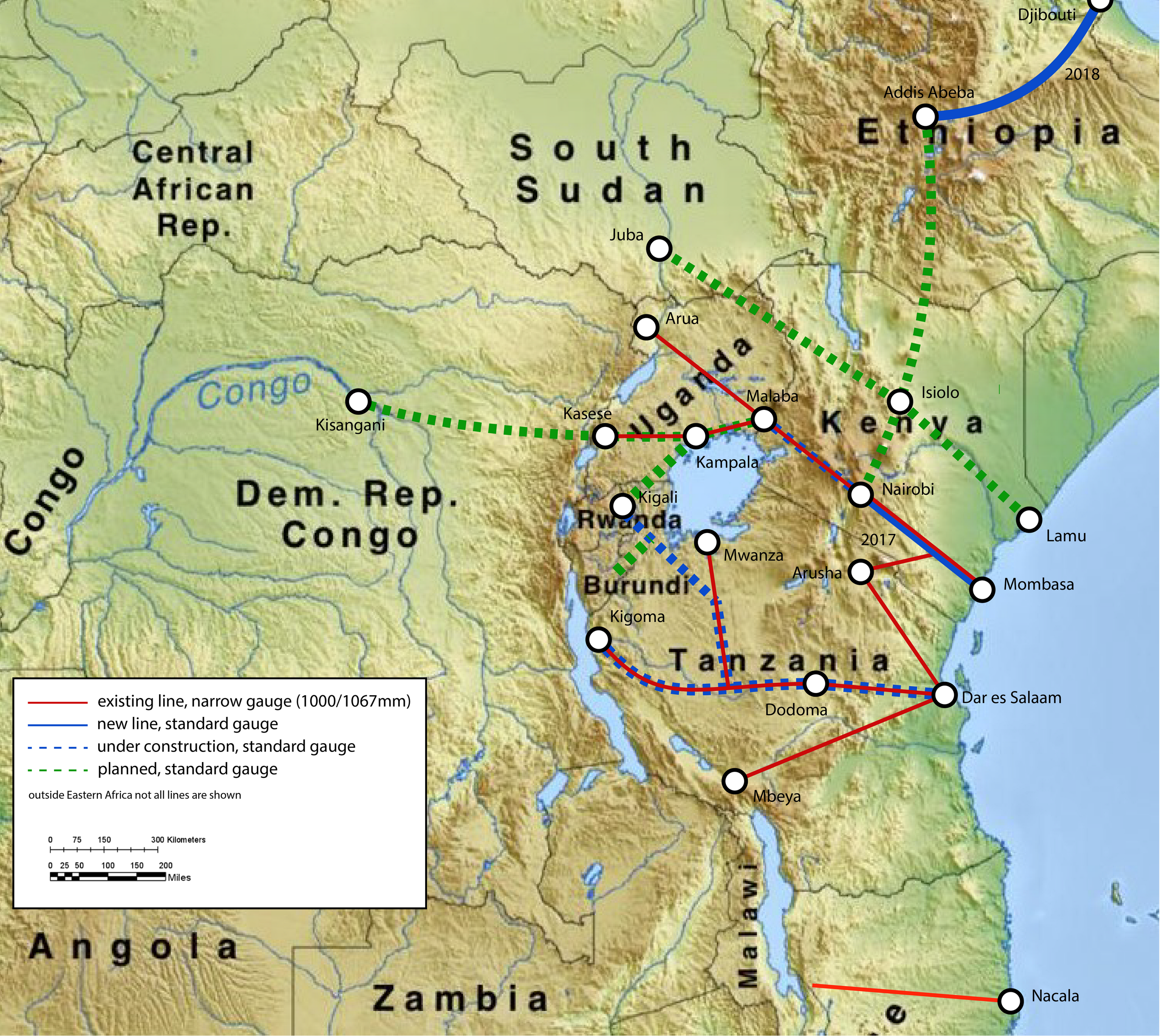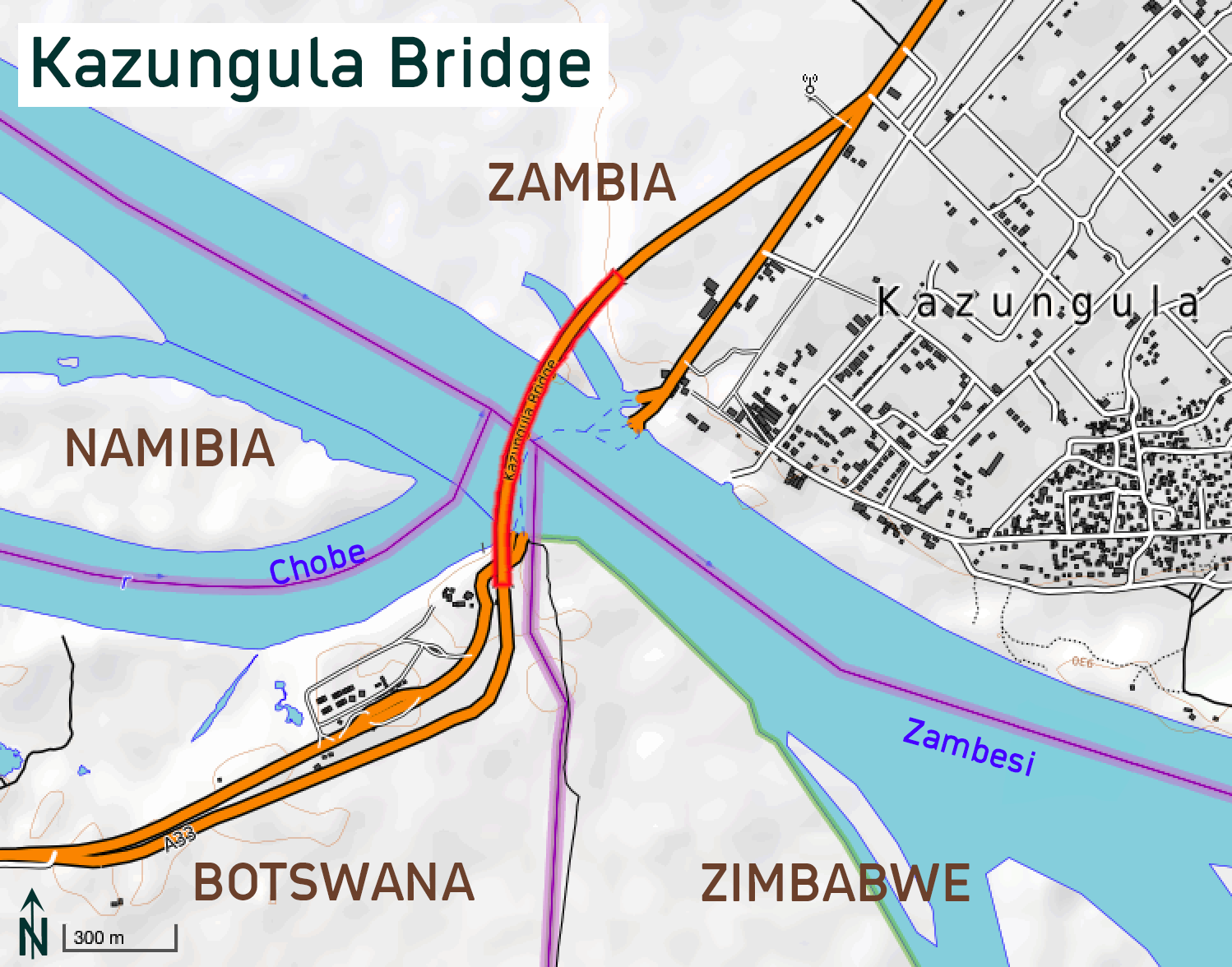|
Rail Transport In Zambia
Rail transport in Zambia is primarily provided by two systems: * TAZARA Railway * Zambia Railways Limited (sub-systems: Cape to Cairo Railway and Sena railway) Zambia Railways operates a number of rail lines, including the Mulobezi Railway; as of early 2012, it was still in operation, but in poor repair. Railway links with adjacent countries * Democratic Republic of the Congo - Ndola to Sakania then Lubumbashi - , freight only. (For extensions and reconstruction beyond Lubumbashi see the DR Congo article). The current operating status of Chililabombwe-DR Congo link not known. * Tanzania - from Kapiri Mposhi, border crossing at Nakonde, Zambia, to Dar es Salaam, TAZARA railway, passenger and freight - * Malawi - Chipata- Mchinji 2010 opening * Mozambique - no direct link, but indirectly to Nacala, Beira (via Malawi) and Maputo (via Zimbabwe, no continuous passenger services). * Zimbabwe - from Livingstone via the Victoria Falls Bridge to Bulawayo, freight only. * Botswa ... [...More Info...] [...Related Items...] OR: [Wikipedia] [Google] [Baidu] |
TAZARA Railway
The Tazara Railway, also called the Uhuru Railway or the Tanzam Railway, is a railway in East Africa linking the port of Dar es Salaam in east Tanzania with the town of Kapiri Mposhi in Zambia's Central Province. The single-track railway is long and is operated by the Tanzania-Zambia Railway Authority (TAZARA). The governments of Tanzania, Zambia, and the People's Republic of China built the railway to eliminate landlocked Zambia's economic dependence on Rhodesia and South Africa, both of which were ruled by white-minority governments.Thomas W. Robinson and David L. Shambaugh. ''Chinese Foreign Policy: theory and practice'', 1994. Page 287. The railway provided the only route for bulk trade from Zambia's Copperbelt to reach the sea without having to transit white-ruled territories. The spirit of Pan-African socialism among the leaders of Tanzania and Zambia and the symbolism of China's support for newly independent African countries gave rise to Tazara's designation as the ... [...More Info...] [...Related Items...] OR: [Wikipedia] [Google] [Baidu] |
Victoria Falls Bridge
The Victoria Falls Bridge crosses the Zambezi River just below the Victoria Falls and is built over the Second Gorge of the falls. As the river forms the border between Zimbabwe and Zambia, the bridge links the two countries and has border posts on the approaches to both ends, at the towns of Victoria Falls, Zimbabwe, and Livingstone, Zambia. History The bridge was the brainchild of Cecil Rhodes, part of his grand and unfulfilled Cape to Cairo railway scheme, even though he never visited the falls and died before construction of the bridge began. Rhodes is recorded as instructing the engineers to "build the bridge across the Zambezi where the trains, as they pass, will catch the spray of the Falls". It was designed by George Andrew Hobson of consultants Sir Douglas Fox and Partners, assisted by the stress calculations of Ralph Freeman, who was later the principal designer of the Sydney Harbour Bridge. The main central arch is a parabolic curve.The Victoria Falls BridgeTo the V ... [...More Info...] [...Related Items...] OR: [Wikipedia] [Google] [Baidu] |
Transport In Zambia
This article is about the transport in Zambia. Railway There is a total of 2,157 km (2008) of railway track in Zambia. Principal lines * Zambia Railways Limited (ZRL) – narrow gauge, 846 km Kitwe-Ndola-New Kapiri Mposhi-Kabwe-Lusaka- Livingstone-Zimbabwe with several freight branches mostly in the Copperbelt totalling 427 km including to DR Congo. Passenger services between Kitwe and Livingstone only. * TAZARA Railway – narrow gauge, 891 km in Zambia: New Kapiri Mposhi-Mpika- Kasama- Dar es Salaam Notable Branch lines * Maamba Colliery Railway, Choma to Masuka, built to carry coal. * The Mulobezi Railway (also known as Zambezi Sawmills Railway) is a narrow gauge line constructed to carry timber from Mulobezi to Livingstone. Has been reported at various times as defunct, currently listed in Railtracker (see 'Railway Network Map' below) but operating status not confirmed. * Mulungushi Commuter Line, later Njanji Commuter Line managed by ZRL, operated ... [...More Info...] [...Related Items...] OR: [Wikipedia] [Google] [Baidu] |
Economy Of Zambia
Zambia is a developing country and it achieved middle-income status in 2011. Through the first decade of the 21st century, the economy of Zambia was one of the fastest growing economies in Africa and its capital, Lusaka the fastest growing city in the Southern African Development Community (SADC). Zambia's economic performance has stalled in recent years due to declining copper prices, significant fiscal deficits, and energy shortages. Zambia is currently ranked 8th in Africa, 5th in the Southern African Development Community (SADC) and 4th in the Common Market for Eastern and Southern Africa (COMESA) in terms of the ease of doing business. Furthermore, Zambia is ranked the 8th most competitive country in Africa on the Global Competitiveness Index. Recently, Zambia was ranked 7th by Forbes as the best country for doing business among 54 African countries. The government has succeeded in reducing the cost of doing business, but other important indicators of the business environme ... [...More Info...] [...Related Items...] OR: [Wikipedia] [Google] [Baidu] |
East African Railway Master Plan
The East African Railway Master Plan is a proposal for rejuvenating the railways serving Tanzania, Kenya, and Uganda and adding railways to serve Rwanda and Burundi. The objective is to further the economic development of eastern Africa by increasing the efficiency and speed, and lowering the cost, of transporting cargo between major ports on the Indian Ocean coast and the interior. All new railways will be standard-gauge, and existing narrow-gauge railways will be rehabilitated. The plan accounts for break of gauge issues and aims for a good interoperability within the resulting hybrid railway network. A later step would expand the eastern Africa railway network to South Sudan, Ethiopia, and the Democratic Republic of the Congo (DR Congo). The plan is managed by infrastructure ministers from participating East African Community countries in association with transport consultation firm CPCS Transcom Limited. New railways The members of the Northern Corridor Integration Project (N ... [...More Info...] [...Related Items...] OR: [Wikipedia] [Google] [Baidu] |
Luacano
Luacano is a town and municipality in Moxico Province, Angola. The municipality had a population of 20,755 in 2014. The Luacano River (''Rio Luacano'') flows past the town to the west before entering the Kasai River, which forms the border between Moxico and Luanda Sul. During negotiations over the border between the Belgian Congo and Portuguese Angola the Belgians pushed for making the Luacano River part of the border. Transport In 2012, a long-awaited short cut between the Angola's Benguela Railway and the Zambian copper mines is being built. The short cut leaves the mainline east of Luacano. See also * Railway stations in Zambia Railway stations in Zambia include: Maps UN Map Principal towns served by rail Existing TAZARA * Serenje * Mkushi * Chilanga * - Tanzania / Zambian border * Tunduma, Tanzania Newly constructed * (opened August 2011) * Mchinji - co ... References Populated places in Moxico Province {{Angola-geo-stub ... [...More Info...] [...Related Items...] OR: [Wikipedia] [Google] [Baidu] |
Huambo
Huambo, formerly Nova Lisboa (English: ''New Lisbon''), is the third-most populous city in Angola, after the capital city Luanda and Lubango, with a population of 595,304 in the city and a population of 713,134 in the municipality of Huambo (Census 2014). The city is the capital of the province of Huambo and is located about 220 km E from Benguela and 600 km SE from Luanda. Huambo is a main hub on the ''Caminho de Ferro de Benguela (CFB)'' (the Benguela Railway), which runs from the port of Lobito to the Democratic Republic of the Congo's southernmost province, Katanga. Huambo is served by the Albano Machado Airport (formerly Nova Lisboa Airport). History Early history Huambo receives its name from Wambu, one of the 14 old Ovimbundu kingdoms of the central Angolan plateau. The Ovimbundu, an ethnic group that originally arrived from Eastern Africa, had founded their central kingdom of Bailundu as early as the 15th century. Wambu was one of the smaller kingdoms and ... [...More Info...] [...Related Items...] OR: [Wikipedia] [Google] [Baidu] |
Rail Transport In Angola
Rail transport in Angola consists of three separate Cape gauge lines that do not connect: the northern Luanda Railway, the central Benguela Railway, and the southern Moçâmedes Railway (southern). The lines each connect the Atlantic coast to the interior of the country. A fourth system once linked Gunza and Gabala but is no longer operational. History Railway construction began in Angola in 1887, while the country was a colony of Portugal. The Luanda Railway opened in 1889, the Moçâmedes Railway opened in 1910, and the Benguela Railway opened in 1912. The railways continued to be extended inland until 1961, when the Moçâmedes Railway reached Menongue. After Angola attained its independence from Portugal in 1975, the Angolan Civil War broke out and lasted until 2002. The prolonged fighting resulted in the destruction of most of Angola's railway infrastructure. The rebels blew up bridges, tore up track, and sabotaged the right of way with land mines to prevent the railway ... [...More Info...] [...Related Items...] OR: [Wikipedia] [Google] [Baidu] |
Rail Transport In Namibia
Rail service in Namibia is provided by TransNamib. The Namibian rail network consists of 2,687 route-km of tracks (2017). Namibia has a history of more than 100 years of railway service. During the colonialisation by the German Empire between 1894 and 1915, a number of railways were built, of which some are still in service today. History Early development The building of German South West Africa railways began with a small mining rail line at Cape Cross in 1895. The first major railway project was started in 1897 when the German Colonial Authority built the "Staatsbahn" (state railway) from Swakopmund to Windhoek. By 1902 the line was completed. Parallel to this government initiative the Otavi Mining and Railway Company (O.M.E.G.) was established which built a line from Swakopmund to Tsumeb via Otavi between 1903 and 1906, and a branch from Otavi to Grootfontein in 1907/08. In 1914 the following railway lines existed: *The Cape Cross line, 2 feet 6 inch gauge; 13 miles l ... [...More Info...] [...Related Items...] OR: [Wikipedia] [Google] [Baidu] |
Kazungula Bridge
Kazungula Bridge is a road and rail bridge over the Zambezi River between the countries of Zambia and Botswana at the town of Kazungula. The by bridge has a longest span of and links the town of Kazungula in Zambia with Botswana. The bridge features a single-line railway track between two traffic lanes and walkways for pedestrians. Before the bridge was opened for traffic in May 2021, direct traffic between the two countries was possible only by ferry. The bridge takes advantage of the short border the two countries share at the river, and is curved to avoid the nearby borders of Zimbabwe and Namibia. History In August 2007 the governments of Zambia and Botswana announced a deal to construct a bridge to replace the existing ferry. Construction of the US$259.3 million project, which includes international border facilities in Zambia and Botswana officially began on 12 October 2014 and was completed on 10 May 2021 by the South Korean construction firm Daewoo E&C. Opening wa ... [...More Info...] [...Related Items...] OR: [Wikipedia] [Google] [Baidu] |




